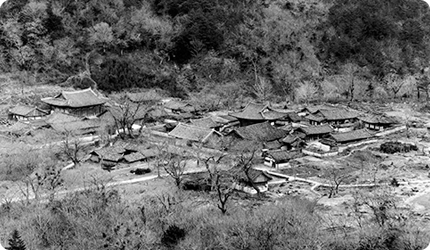Buddhist Mountain Monasteries in Korea
Daeheungsa Temple
Daeheungsa Temple
Introduction
Natural Environment
History
Temple Layout
Cultural Properties
Information
History of Daeheungsa Temple
-
- Records pertaining to the founding of Daeheungsa Temple include Jungmigi, Maniramgogi, and Bugamgi.
The year of its foundation is 426 according to the Silla Jeonggwanjonja Foundation Theory based on Maniramgogi, 514 according to the Ado Hwasang Foundation Theory according to Jungmigi, and 875 according to the National Preceptor Doseon Foundation Theory.
However, according to Daedunsaji issued in 1823 (23rd year of King Sunjo’s reign), Hyejang, who was in charge of collecting the historical records, stated that there was no basis for the foundation theories claimed in these records, considering the period of activity of Ado Hwasang and the year of birth of National Preceptor Doseon. Accordingly, at this time, it is difficult to determine the exact time period of the founding of Daeheungsa Temple. Nevertheless, it can be roughly estimated in light of the artifacts and the historical circumstances. -
 Daeheungsa Temple during the Japanese occupational period
Daeheungsa Temple during the Japanese occupational period
- Records pertaining to the founding of Daeheungsa Temple include Jungmigi, Maniramgogi, and Bugamgi.
The year of its foundation is 426 according to the Silla Jeonggwanjonja Foundation Theory based on Maniramgogi, 514 according to the Ado Hwasang Foundation Theory according to Jungmigi, and 875 according to the National Preceptor Doseon Foundation Theory.
-
-
 Three-Story Stone Pagoda of Daeheungsa Temple
Three-Story Stone Pagoda of Daeheungsa Temple
- First, the Three-Story Stone Pagoda (Treasure No. 320) found in front of Eungjindang Hall is estimated to have been built in the late Unified Silla Period.
Also, according to Donggugyeojiseungnam published in 1481 (12th year of King Seongjong’s reign), there were stupas for the enshrinement of the sariras of great masters Sinam, Chongeun and Seongyu in the front yard of the temple, and while there are no specific personal records of these monks, it has been revealed that they were monks during the Goryeo Dynasty.
Based on these factors, it can be inferred that Daeheungsa is a temple that was founded at least in the late Unified Silla Period before the founding of Goryeo.
Considering that there are insufficient information and records regarding Daeheungsa from the Goryeo period, it is most likely that the standing of Daeheungsa was greatly promoted only after the mid-Joseon Period when the robe and alms bowl of Great Monk Seosan were placed here and the temple began attracting attention from the Buddhist community and the royal court. Great Monk Seosan, who significantly contributed to the State by organizing monk troops during the Japanese Invasion of Korea in 1592, requested that his robe and alms bowl be retained at Daeheungsa Temple as he considered it as a place that will not be under the impact of the three calamities and be undestroyed for 10,000 years. Accordingly, his robe and alms bowl was transferred to the temple in 1604 (37th year of King Seonjo’s reign), after which it produced 13 great patriarchs (Daejongsa) and 13 great senior instructors (Daegangsa) despite the oppression of Buddhists in the Joseon Dynasty and developed into a large Seon Buddhist temple and bodhimandala.
-
Chronological Table
| Time Period | Description |
|---|---|
| Late Unified Silla Period | Founding of Daeheungsa Temple |
| Goryeo Dynasty | Rock-Carved Seated Buddha and Three-Story Stone Pagoda of Bungmireugam and the stupas with the enshrinement of sariras of Sinam, Saeun and Seongyu are constructed |
| 1604 | The robe and alms bowl of Great Mong Seosan are brought to Daeheungsa |
| 1630 | Jinburam is reconstructed by Geukhyeon and Deokho, etc. |
| 1647 | Memorial stone and stupa of Great Monk Seosan are erected |
| 1665 | Daeungbojeon Hall is rebuilt by Simsu |
| 1675 | Maniram is rebuilt by Yungsin |
| 1683 | Jiburam is reconstructed |
| 1740 | Gojinburam is reconstructed by Wiil |
| 1743 | Hyangjeokjeon is reconstructed by Duwon |
| 1761 | Cheongundang is reconstructed by Cheongundang |
| 1780 | Eunseonam is reconstructed by Cheongdam |
| 1788 | Gyehong and Cheonmuk, etc. sends a letter to the royal court for the establishment of a shrine to honor Great Monk Seosan and to issue a tablet |
| 1789 | The shrine is constructed under the order of the royal court and the tablet, “Pyochung,” written by King Jeongjo is bestowed |
| 1791 | Seosandaesapyochungsagijeokbi is constructed and Jeongneung rebuilds Gojinburam |
| 1797 | Namam is rebuilt by Jeonhwon |
| 1809 | Maniram is reconstructed by Jaam and Eunbong |
| 1811 | The Dharma halls, shrines, and subsidiary buildings including Cheonbuljeon are destoryed by fire |
| 1812 | Yonghwadang is reconstructed |
| 1813 | Cheonbuljeon is reconstructed by Wanho, etc. |
| 1841 | Daegwangmyeongjon (Birojeon) is reconstructed by Seon Master Choui |
| 1899 | The buildings in northern compound are burnt down due to fire at Seosangsil |
| 1900 | The Daeungjeon area is reconstructed by Yukbong |
| 1912 | Daeheungsa is designated as the main temple governing over 44 monasteries and hermitages nearby |
| 1978 | Great Monk Seosan Artifact Hall is constructed |
| 1993 | The name of the temple is changed from Daeheungsa to Daedunsa |
| 2003 | The name of the temple is changed from Daedunsa to Daeheungsa |
